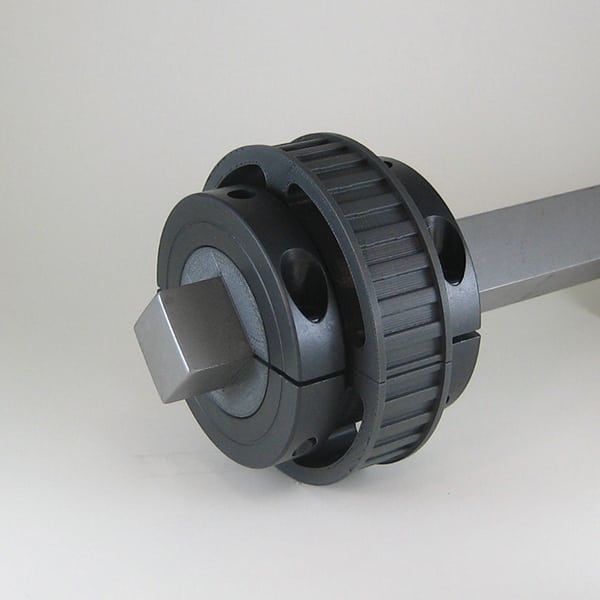New 3-D Printing System Creates Precision Shaft Collars
Shaft collars are used as stops or locators on shafts in a wide variety of applications. There are two basic types. One uses a setscrew to lock the collar in place, while the other utilizes a clamp-type collar.
Shaft Collar Designs
Setscrew collars are the oldest type of shaft collar. These units function by gouging the setscrew into the surface of a shaft. They are a low-cost answer when frequent adjustment is not necessary.
Clamp-type collars (also known as split collars) are designed to retain their position through the clamping power generated by tightening one or more clamp-screws, which do not touch the shaft. The primary benefits of clamp-type collars are that while they are non-marring and easy to adjust, they have a consistently high holding power when used on hard or soft shafts. They are available in an assortment of materials and styles.
Clamp-type collars can be used for a variety of functions. They can act the same as a shoulder on a shaft when clamped in position, but they are much less expensive than machining a shoulder, and they can be easily moved to a new location, if necessary. The collar can also be used as a clamping mechanism over a split-hub. In this case, the clamping power is transmitted from the collar to the hub-shaft interface. The self-centering split-hub design is a common way to connect components to a shaft as a torque-transmitting component when other torque-inducing components, such as lever arms, pulleys, and sprockets, are fastened to it.
3-D Printing Offers a Solution
In certain situations, such as when a bearing fails, resulting in slight damage to a shaft or collar, a unique replacement may need to be constructed using dimensions developed in the field (Figure 3). The process can take some time and will often keep a piece of equipment out of service for the duration.
 |
| 3. Print on demand. The 3-D printed insert is held in place on a shaft using master collars. Courtesy: Stafford Manufacturing Corp. |
Recently, Stafford Manufacturing Corp. developed a rapid prototype and repair collar system, which lets users create their own working prototypes of special-purposed shaft collars within a few hours. Called the SPARC (Stafford Prototype and Repair Collar) system, it features precision-machined shaft collar masters, which are available from stock and accept 3-D printed inserts.
“We have great hopes for the system,” said Arthur Stafford, president and founder of Stafford Manufacturing. “It’s a very interesting technology. What we’re trying to do is develop a large database of designs that will work with these products—that have utility.”
Combining the clamping strength of a conventionally machined shaft collar with the flexibility of unlimited insert configurations, users can create custom-designed inserts with bores to fit virtually any type of shaft, while accommodating for features such as holes, bosses, slots, tabs, hubs, pulleys, and other items.
“The insert is pretty basic as is, but it can do a lot of different things just limited by the imagination and what the user wants to do with it,” Stafford said.
Getting Started
Supplied in steel, stainless steel, or aluminum, masters currently come in three sizes to accommodate shaft diameters from one-eighth inch to three inches. The 3-D printed inserts in the SPARC system can be either user-defined or selected from a library of computer-aided design drawings offered free by Stafford.
Printing can be done onsite with a 3-D printer, which saves time, and the inserts are designed to mate securely with the master to create a unified working part. Although 3-D printers are not commonplace at many facilities, the equipment is readily available in a wide range of capabilities and build-area sizes. Entry-level models can be purchased for under $1,000, while some third-generation models with excellent user ratings can be obtained in the $1,500 to $3,500 range. High-end models can get pricey, costing up to $40,000 or more.
Materials used in the printing process vary, but Stafford has created inserts using a material commonly called ABS (acrylonitrile butadiene styrene). It is a thermoplastic polymer material that is strong, flexible, durable, and offers good resistance to heat and chemicals. These characteristics, along with the material’s machinability, make it a preferred plastic for many engineering and professional applications.
When using ABS, it is important for the 3-D printer to have a heated bed to minimize upward curling of the surface in direct contact with the print bed. The cost for ABS is roughly $4.50 to $5.00 per cubic inch of printed product. ■
—Jim Swiezynski (jswiezynski@ staffordmfg.com) is technical director for Stafford Manufacturing Corp.